The Trongate was originally known as St. Thenew’s Gait because it was the way to St. Thenew’s Chapel, named after the mother of St. Mungo, and situated where St. Enoch Square is today. It should be noted that the term “gait”, also spelled “gate”, does not refer to a gated entry but is instead an old Scottish word meaning “the way to”. In 1491, a trone or balance for weighing goods was set up at Glasgow Cross and St. Thenew’s Gait subsequently became known as the Tronegait or the way to the trone.
We are now approaching the intersection with Glassford Street on the left and Stockwell Street which is off camera to the right. On the right is part of the Granite House building which occupies a prominent position on the corner with Stockwell Street. They are holding a sale of men’s and youth’s clothing and this was probably a regular event. Gow & Son, the Upholsterers, occupy the building next door and beyond is Slater’s, known as the Great London Tailors. ( Postcard published by E. A. Schwerdtfeger & Co., London E. C. and printed in Berlin. )
It’s just 12.30 by the Tron Steeple clock in this sunny 1920 view and the north side of the street is busy. All of the women in the picture are wearing hats, most of which are in transition from the broad brim to the narrow style that would become popular during the 1920’s. On the south side of the street, the Britannia Panopticon, which served as both a theatre and a cinema, is showing the “The Wilderness Trail”, a 50-minute silent Western in black and white that had been released in the U.S.A. on 6 July, 1919. ( Valentine’s X L Series )
This high-resolution printed view depicts a scene in the Trongate looking east to Glasgow Cross, circa 1903/4. The Tolbooth Steeple visible in the distance still attached to the five-storey building modified from the original Tolbooth. In the foreground of the picture, the entrance to King Street is on the immediate right and Candleriggs is on the left. The clock on the Tolbooth Steeple reads a quarter past ten and the one on the Tron Steeple reads a quarter past six, so at least one of them is wrong. The Tron Steeple, built in 1637, is all that remains of the Collegiate Church of St Mary and St. Anne which was burned down by drunken members of the Hellfire Club in 1793. A replacement church built to a design by James Adam was completed in the following year and now houses the Tron Theatre.
In the distance, one of the original “Room and Kitchen” single-deck tramcars is approaching its London Street ( later London Road ) terminus. These trams were not an unqualified success and most did not last long in active service beyond 1905. They were subject to frequent derailments which is why they were latterly placed on the relatively straight London Street to Clydebank route.
We are now approaching the eastern end of the Trongate as we head towards Glasgow Cross in this mid to late 1920’s scene. The Tron Steeple is visible on the right and, in the distance, the now freestanding Tolbooth Steeple is coming into view. King Street is on the immediate right and the Scottish Clothing Company is advertising merchandise costing 21 and 30 shillings each, possibly coats or suits. Further along is a vendor of prams and Jack’s Doll Hospital. In the days before plastic became popular, dolls were made of ceramic material and they would often be subject to cracking and breakage. Because such dolls could be expensive to replace, there was clearly a business for Jack in repairing them. Six tramcars are in view and Car 128 nearest the camera is on the long run out to Dalmuir West. ( Anonymous publisher )
In this later photograph, the items on sale in the foreground are Ladies Rain Coats, 30/- ( or possibly 36/- ) and Ladies Waterproof Coats, 24/-. We cannot be certain that these are the same items as advertised in the previous photograph ( subject to price inflation ). What could be the difference between the Rain Coats and the cheaper Waterproof Coats? Perhaps the Rain Coats were made of more expensive fabric but were not guaranteed to be waterproof. The Waterproof Coats were certainly not “plastic macs” as they were not available in the 1920’s. The term “mac” is derived from Charles Macintosh, a Glasgow industrial chemist, who applied a solution of rubber dissolved in naphtha to fabric and found that the resulting material was waterproof once the naphtha had evaporated. Coats manufactured in this way with a layer of rubber sandwiched between two layers of fabric became known as Mackintoshes ( with a k ) and the first one was sold in 1824.
The image on this postcard may be a reproduction of an 1870’s Thomas Annan photograph of the Tontine Hotel. It was established in 1783 after the Tontine Society purchased the original buildings and converted them into a hotel. As well as catering to travellers, the Tontine Hotel was renowned for its coffee room which proved very popular as a place to conduct business, while its assembly rooms hosted regular social meetings and dances.
In 1897, the statue of King Billy on his mount was moved from the location shown in this view to one in the centre of the Trongate, facing west and in front of the new Glasgow Cross Station building designed by J. J. Burnet for the Caledonian Railway Co. By this time, the Tontine building had ceased to be a hotel, and space has been leased for use as a warehouse by the drapers Moore, Taggart & Co. The arches at the front were subsequently obscured by store front. Sadly, in 1911, there was a serious fire on the premises.
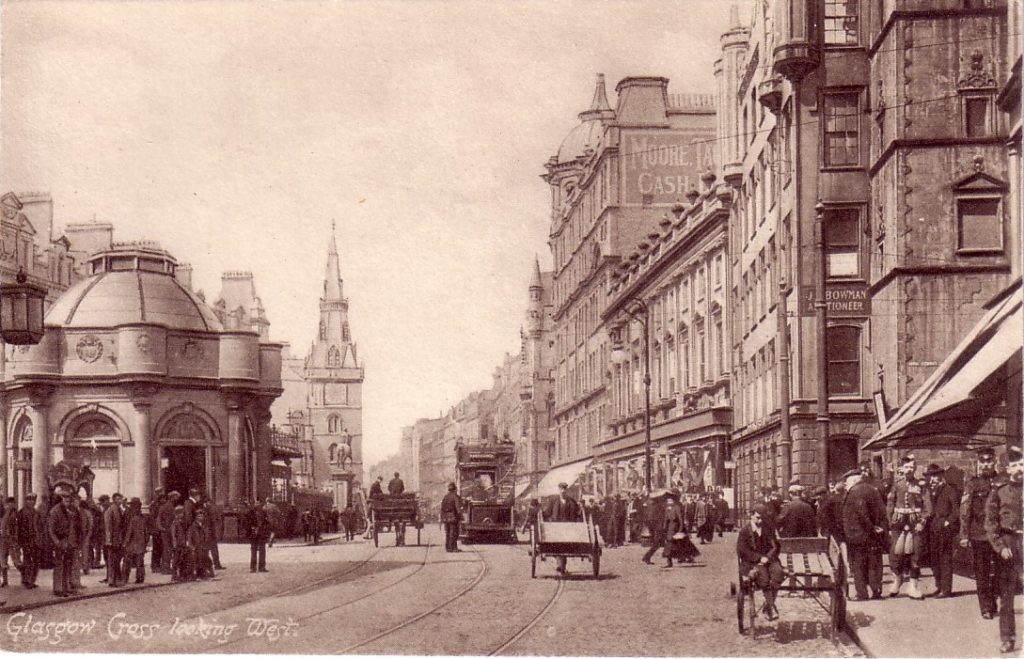
In this scene, taken before 1910, we are looking west from the Gallowgate across Glasgow Cross, and down the Trongate. There are military personnel in the right foreground, including one soldier in full dress uniform with a kilt, spats and a chest full of medals. Perhaps a recruiting campaign was underway and there was a recruiting office in nearby Rendezvous Court. Beyond the soldiers, the Tolbooth Steeple and Building are visible across the entrance to the High Street. The curious ornate octagonal building on the left of the picture is the Caledonian Railway building ( 1896 ), designed by J. J. Burnet and part of Glasgow Cross Station whose platforms were below street level. The wrought ironwork on the other side of the building enclosed a ventilation shaft that allowed smoke to escape from the tunnels below. Beyond this, the mounted statue of King William III, Prince of Orange, better known as King Billy, looks down the Trongate, taking in the view with the Tron Steeple on the left. King Billy’s statue was in the Trongate for 163 years before it was taken down in 1923 and, after a short period in storage, erected in the Cathedral precinct in 1926. ( Postcard published in the Philco Series. )
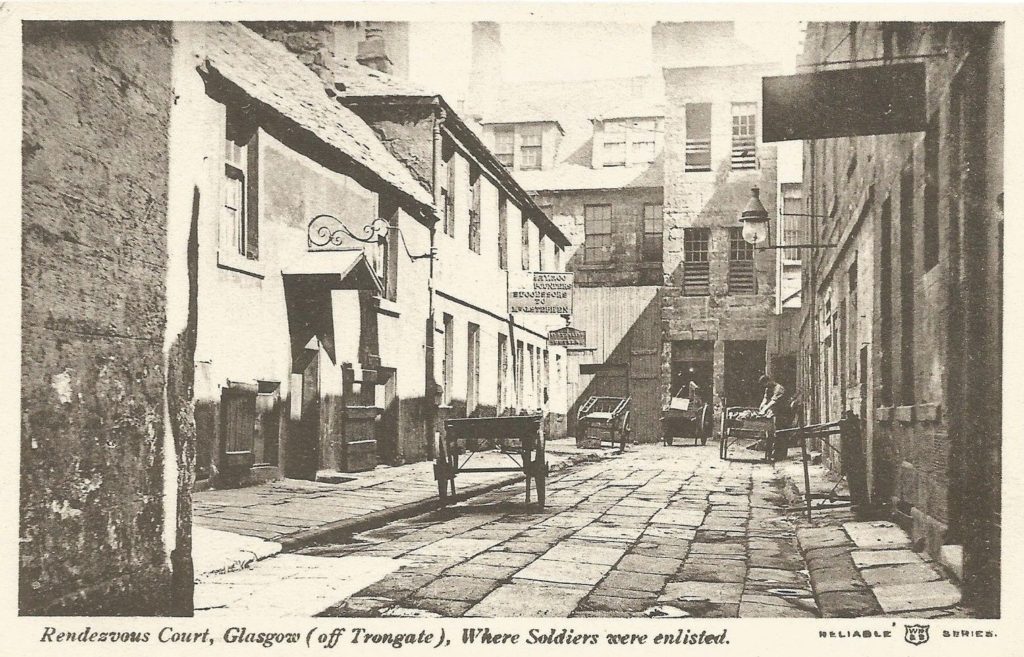
Rendezvous Court, just off the Trongate near the Tontine building, was the location for an army recruitment centre. The soldier seen in the vicinity in the previous photograph, wearing full military dress, complete with medals and spats, may have been seeking recruits. ( Postcard published in the Reliable Series. )
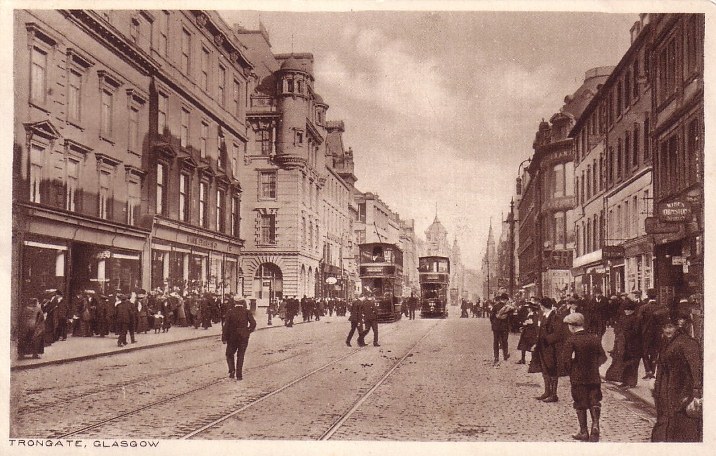
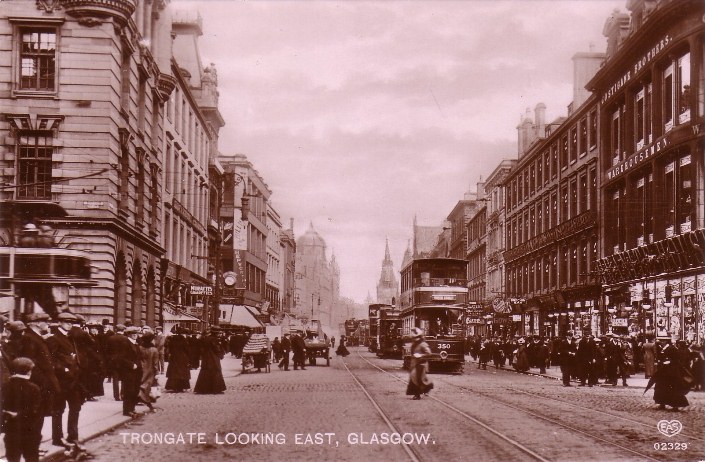

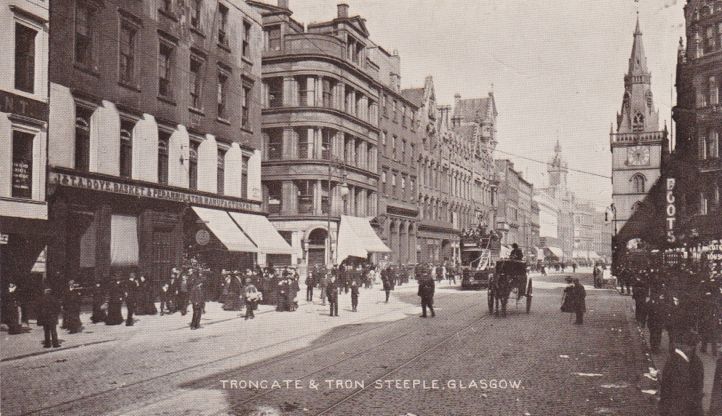
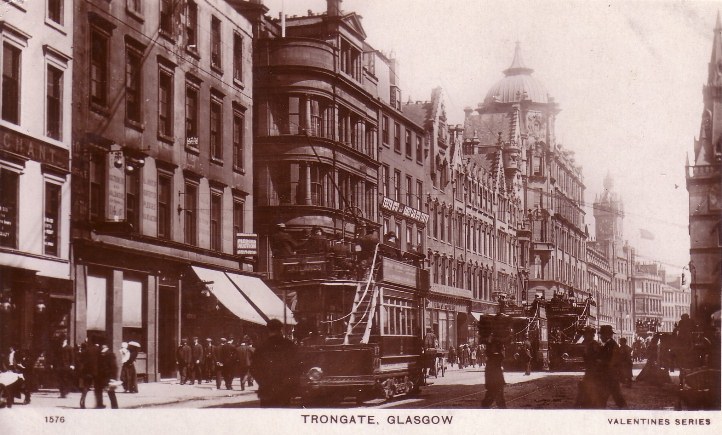
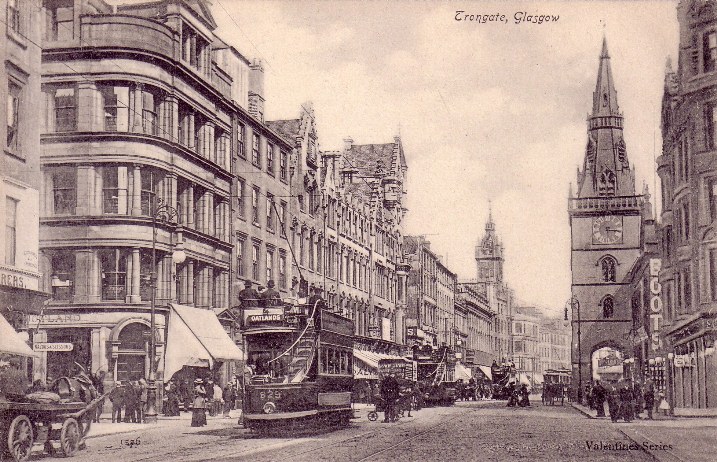
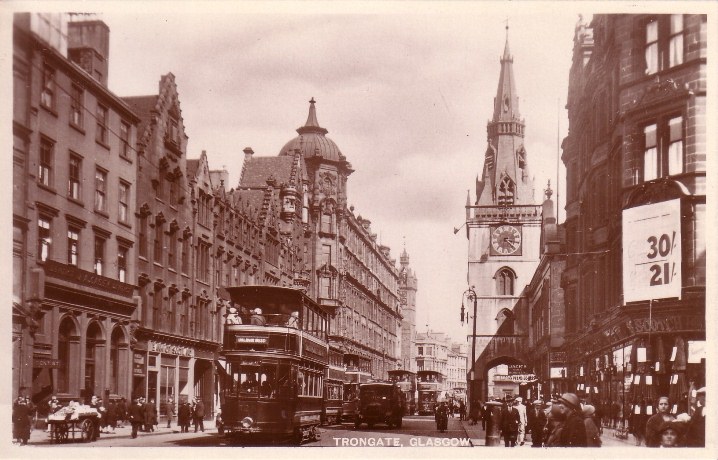
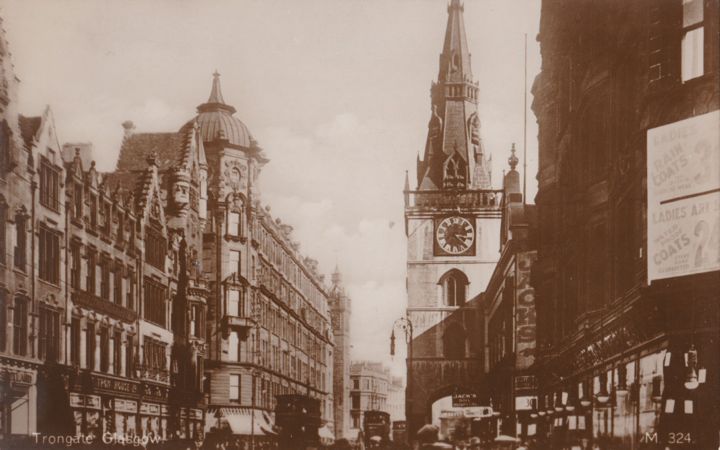
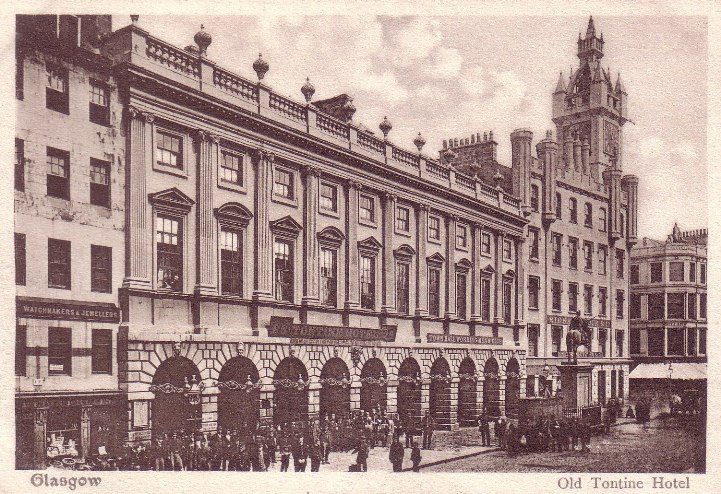

{ 1 trackback }
{ 29 comments… read them below or add one }
Dear Chris,
My name is Nicola and I am studying for an M.Sc. in Publishing at Edinburgh Napier University. We are currently working on a podcast on the life of Glaswegian writer Catherine Carswell and I came across the magnificent collection of early 20th century photographs of the city on your blog. I was wondering if you are interested in collaborating with us on the project or if there is a way for us to use some of your images. I am more than willing to further explain what we are doing. Please send me an e-mail if you are interested. This website is truly a treasure trove.
Thank you and all the best,
Nicola Bieg
Hello Nicola,
Thank you for your message and I will be happy to help. Except where otherwise stated, the images are from my own collection and you are welcome to use them for your project. Thank you for your interest in Glasgow history and I wish you success in your venture.
Chris
Dear Chris,
Thank you very much. I really appreciate your help! We will come through to Glasgow on a day in March or April to film some contemporary scene, so if you would want to give us your opinion on how Glasgow life was like in the early 20th century, we’d be delighted!
Otherwise, thank you for your willingness to let us use your images, I’d be happy to send you the final podcast if you are interested.
All the best,
Nicola
Hi Chris,
This is a wonderful site, a great resource full of interesting entries. The Trongate is one of my favourite parts of the city, so it was nice to read about the history. I’m writing a blog post linking to your Broomielaw entry. I can’t for the life of me figure out how to follow you. The subscribe button doesn’s work (at least not in a way I’m familiar with!). I look forward to reading more of your work.
Jean
Hi Chris,
Love the pictures.
Would you mind if I print off a couple to do a then and now series on a website that I am a member of? I would obviously credit your name as the source.
Thanks,
Martin.
Hi Martin,
Thank you for your comment and you are welcome to use some of the photographs for your “then and now” series.
Best wishes,
Chris
Hi Chris,
I have recently become Editor of the newsletter for Clydesdale Bank pensioners known as Onward. This is distributed free to all Clydesdale Bank Pensioners and is used to distribute news, information and items of interest to the recipients. One area of great interest is stories about old branches across the UK and it is always good to illustrate these with old photographs. I came across your excellent site today whilst researching some of the Glasgow branches and wondered if it would be possible to reproduce relevant photographs from time to time? I would, of course, ask your permission before using particular images.
Kind regards,
Jim
Hi Jim,
Thank you very much for your inquiry and congratulations on your new appointment. You are most welcome to use images from this archive to illustrate your articles about old Clydesdale Bank branches in Glasgow.
Wishing you the best of success.
Chris
Hi Chris,
This website is truly Gold! I am an architect who recently graduated from Mackintosh. As a part of the Merchant City Festival this year, I am organizing a walking tour across some of the listed buildings around Merchant City and reading this article was great to learn more about the Trongate. The walking tour is combined with an Augmented Reality experience. It will be extremely valuable to use some of the relevant images for the Augmented Reality experience and I request your permission to do so. If you would like to chat more on the project, I’ll be happy to do so. And it goes without saying, but I will be giving complete credits for the images to you!
Cheers,
Pooja Katara
Hi Pooja,
Many thanks for your comment and congratulations on your recent graduation. Your project sounds very interesting and you are most welcome to use whatever images you wish for your walking tour and Augmented Reality experience. I am far from Glasgow at the present time otherwise I would like to join your tour.
Best wishes,
Chris
Hi, This is a great website. I’m tracking the late c18 and early c19 road out east along the Gallowgate and am esp interested in the Tontine Hotel where the stage coaches started from. Do you know if the present huge sandstone building with the James Watt plaque is on the site of the arcaded hotel burnt down in 1911? Do you know when the present sandstone building was built? I’m finding different websites confusing on this. Thanks, Alverie
Hi Chris,
This is a great website. I’m tracking the late c18 and early c19 road out east along the Gallowgate and am especially interested in the Tontine Hotel where the stage coaches started from. Do you know if the present huge sandstone building with the James Watt plaque is on the site of the arcaded hotel that burnt down in 1911? And do you know when the present sandstone building was built? I’m finding different websites confusing on this. Thanks, Alverie
Hi Averie,
Thank you for your comment and question. The large red sandstone building with the dome at the end occupies the space where the Tontine Hotel once stood. The plaque on the red sandstone wall marks the location of James Watt’s workshop where he worked to service and repair the scientific instruments used in the University.
Best wishes,
Chris
Hi Averie,
Thank you for your comment and question. The large red sandstone building with the dome at the end occupies the space where the Tontine Hotel once stood. The plaque on the red sandstone wall marks the location of James Watt’s workshop where he worked to service and repair scientific instruments used in the University.
Best wishes,
Chris
Hi Chris,
I’m looking to find my ancestor’s street, Back Wynd. I know it was near a theatre as I found a photo online of the street which showed a sign with theatre door. I’d like to visit but I’m unsure what the theatre was. Could it be the Britannia?
Your help would be most appreciated. Thank you.
Jane
Hi Jane,
Thank you for your inquiry and I think you are on the right track. There is a photo of the Back Wynd taken from the Trongate and dated 1899 which would be after Thomas Annan’s time. Perhaps it was a re-publication of a photograph taken much earlier. Annan started photographing the slum areas around the High Street and Glasgow Cross in 1866 and his famous work entitled “Old Closes and Streets of Glasgow” was produced between 1868 and 1871. I have copied and enlarged the photograph referred to above and the sign clearly states Britannia Stage Door. The theatre building is to the right of the lane as seen in the photograph, reportedly taken from the Trongate.
The theatre began life as the Britannia, opening in the Trongate in 1859, and in the early 1860’s its name was changed to the Britannia Music Hall. It would certainly have been operating when Thomas Annan was taking his photographs. Its name was later changed to the Britannia Panopticon and it remained this way until it closed in 1938. It reopened in 2003 and is still in operation today.
Recent photographs show no lane to the left of the Britannia building as seen from the Trongate. There is a lane called New Wynd running down the right-hand side and this is clearly indicated in one of the photos on http://www.arthurlloyd.co.uk/Glasgow/Britannia.htm
Putting all this together would suggest that the Back Wynd was built over, certainly the part that ran down the east side of the Britannia building, assuming that the early photograph was correctly labelled as being taken from the Trongate.
Best wishes,
Chris
Hi Chris,
I would be interested to know if you have any information on a business run by future steelmaker David Colville.
According to the gracesguide.co.uk website, Colville moved to Glasgow in the late 1840s and traded as a provisions merchant until he went into the iron industry in 1861, before building the Dalzell Iron & Steel Works in Motherwell a decade later.
Thanks,
Justin
Hi Justin,
Thank you for your inquiry and the information regarding David Colville. I checked some issues of the Post Office Annual Glasgow Directory for the years before David Colville went into the iron industry and in the 1850/51 General Directory section he is listed as Colvill, David, tea and coffee dealer, 50 Trongate. In the 1855/56 issue, the listing is Colvill & Co. Tea and coffee dealers, 50 Trongate. House 101/2 N. Albion St. The premises at 50 Trongate were to the west of Glasgow Cross and quite close to the Tontine Hotel, famous for its reading and coffee room.
Best wishes,
Chris
Hi Chris,
This is a great piece. Thanks for sharing it with us. I was wondering if I could use your photos for an instagram post on now vs the past of Trongate in Glasgow?
Much appreciated.
Thanks.
Juber
Hi Juber,
Thank you for your request and you are welcome to use the photographs for your Instagram post. Please acknowledge the website if you have an opportunity.
All the best,
Chris
Hi Chris,
I am researching my ancestor’s apartment at 118 New City Road (1905 to 1941). Unfortunately, however, construction of the M8 Motorway has taken much of the road’s housing. My great grandfather was a commercial traveller with a large family — ten adults lived at 118. Do you know of any early 20th C street image showing Number 118 or its neighbours?
With thanks,
David
Hi David,
Thank you very much for your inquiry and I performed a search for images of New City Road and of Cowcaddens, the area in which the tenement would have been located. On checking the Post Office Annual Glasgow Directory for 1910-1911, your ancestors’ address on New City Road was situated in the block between Rosehall Street and Abercorn Street ( https://digital.nls.uk/directories/browse/archive/90524994 ) so these would also be locations of interest. Photos of Cowcaddens are posted online from time to time, for example on the Glasgow Chronicles Facebook page, so I would recommend checking periodically to see if they feature scenes close to the location of your ancestors.
With best wishes,
Chris
Hi Chris,
I was wondering if you have any information on Francis Rae who ran an upholstery business at 170 Trongate and his house was at 84 Crown Street, according to the 1839 to 1843 Scotland Post Office Directories.
Francis was an upholsterer, residing at 124 Trongate in the 1841 Scotland census. There appear to be many people listed at this same address. Can you give me any help explaining this? Any help would be appreciated.
Regards,
Trish Jones
Hi Trish,
Thank you very much for your inquiry. It is possible that Francis moved from Crown Street to 124 Trongate to be closer to his business and that his former address was not updated in the Post Office Directory. The fact that many people were listed for the 124 Trongate address would suggest a tenement location. In tenements with four floors, there would be eight flats, two on each floor, so many individuals and families could be housed.
Best wishes,
Chris
Hi Chris,
Two of my great great grandparents were married in Glasgow in 1865 and both give their ‘usual residence’ as 17 Trongate, Glasgow. Do you know where in the Trongate this would have been located and what sort of accommodation it was likely to have been? His occupation is given as Moulder (journeyman) and hers as Warehouse worker.
I am doing my family tree and extra information adds colour to what just becomes a list of names and dates. Any help would be much appreciated.
Regards,
Gillian
Hi Chris,
I’ve been doing my Family Tree for over 20-years and have come across many connections to Glasgow. I found that one of my Aunts in the 1921 Census was noted as a “Kitchen Maid” at the “Central Station Hotel, Trongate”! Do you have any further information on this Hotel or maybe even photographs? Hope to hear from you soon.
Many thanks, Davy.
Hi Davy,
Thank you for your inquiry. The Central Station Hotel still exists, albeit under a new name and new ownership, the voco Grand Central. It is joined to Glasgow Central Station and has frontage on Gordon Street and Hope Street and was initially owned and operated by the Caledonian Railway Company. Here is a link to more information and photographs: https://en.wikipedia.org/wiki/Grand_Central_Hotel_(Glasgow) I also checked the Post Office Annual Glasgow Directory for 1921 and no Central Station Hotel was listed for the Trongate which is a busy thoroughfare about a 20 minute walk to the East from Central Station. Perhaps your Aunt resided in the Trongate and worked at the Central Hotel.
I hope this helps.
Best wishes,
Chris
Hi Chris,
This is a wonderful archive that you have created. I find it very interesting. I came across your site whilst researching my family tree.
My great grandmother worked as a cook and my grandfather as a younger man worked as a Hotel Boots. I have found information regarding a Hotel Cecil 128 Trongate. I’m wondering if this hotel existed or is it just another cul-de-sac I find myself in. Thanking you in advance for any help you may provide.
Regards,
John McCurrach
Hi John,
Thank you for your inquiry and I have been checking the Post Office Annual Glasgow Directories for the late 19th and early 20th Centuries. I can confirm that in the 1910-1911 Directory, for example, there is indeed a Hotel Cecil listed at 128 Trongate. Here is the link: https://digital.nls.uk/directories/browse/archive/90526026
With best wishes,
Chris